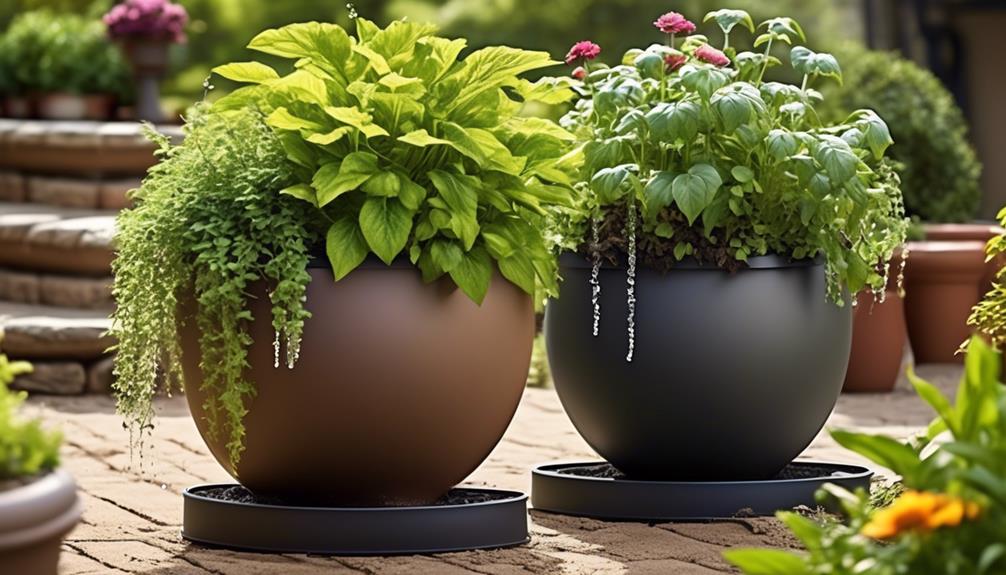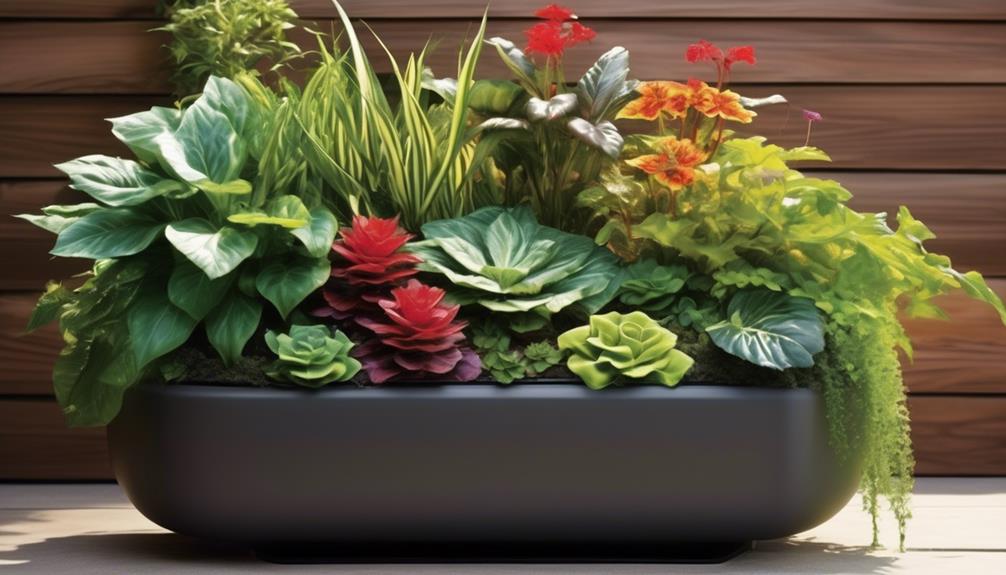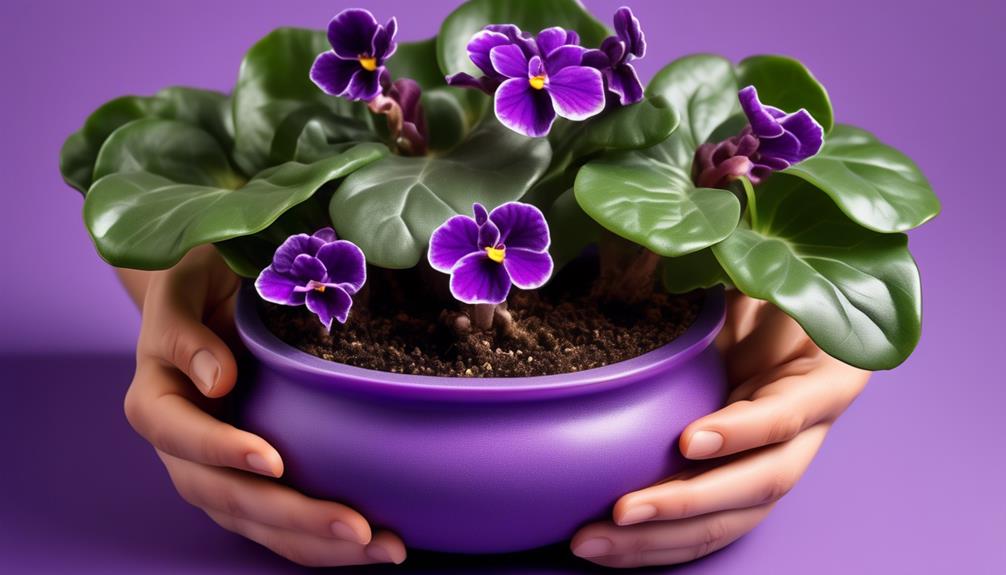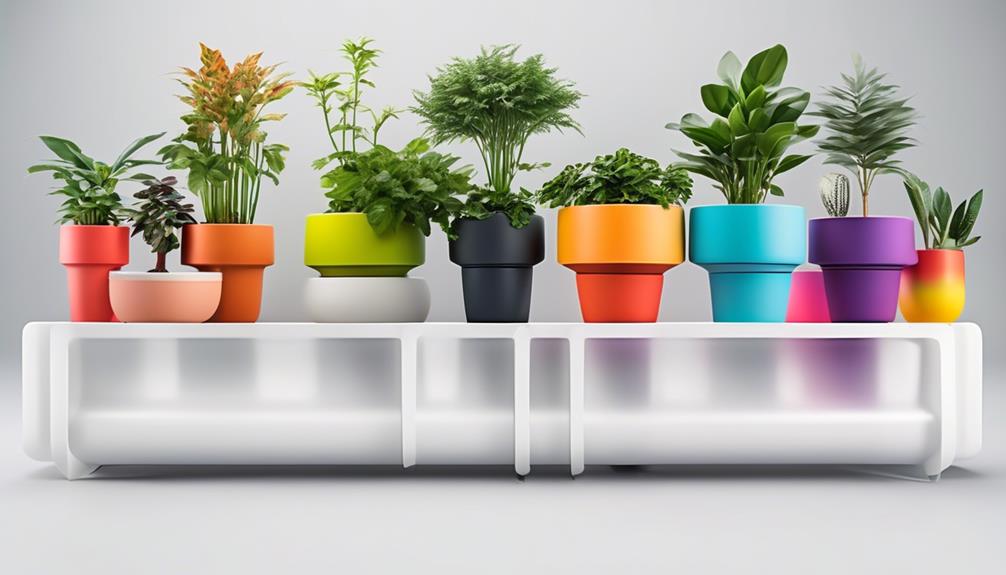Self-watering plant containers will automatically keep your plants hydrated, removing the need for constant monitoring.
But have you ever wondered just how they manage to do that? The science behind self-watering planters is fascinating, and it goes beyond just having a water reservoir.
There are intricate mechanisms at play that ensure your plants receive just the right amount of hydration, and understanding these mechanisms can revolutionize the way we care for our green companions.
Key Takeaways
- Capillary action and moisture retention are crucial for self-watering planters to work effectively.
- A reservoir system is used to efficiently distribute and store water in self-watering planters.
- Soil moisture sensors are used to monitor and regulate the water content in the soil, preventing under and over-watering.
- The wicking mechanism ensures even distribution of water throughout the soil, promoting uniform growth and healthy root development.
Capillary Action in Self-Watering Planters
Capillary action in self-watering planters occurs when water is drawn upward through a porous material, such as soil or wicking fabric, due to the adhesive and cohesive forces between the water molecules and the material. This phenomenon is crucial for maintaining moisture retention and ensuring efficient root hydration within the planter.
When the soil or wicking fabric is in contact with the water reservoir in the self-watering planter, the water molecules adhere to the material's surface due to adhesive forces. Simultaneously, cohesive forces between the water molecules cause them to stick together, allowing them to move collectively through the tiny spaces in the material.
As the water moves upwards, it saturates the surrounding soil, providing a continuous source of moisture for plant roots. This process is essential for sustaining optimal soil moisture levels, preventing over or under-watering, and promoting healthy plant growth.
Understanding the principles of capillary action is fundamental for designing effective self-watering planters that can support thriving plant life.
Reservoir System: Water Storage and Distribution

The efficient distribution and storage of water in self-watering planters is facilitated by the reservoir system, which builds upon the principles of capillary action to sustain optimal soil moisture levels and promote healthy plant growth.
The reservoir system operates through a series of interconnected channels and porous materials, which allow for the controlled movement of water within the planter. This system ensures that water is efficiently drawn from the reservoir to the surrounding soil as needed, preventing both waterlogging and drought stress.
Additionally, the reservoir system incorporates advanced irrigation techniques such as sub-irrigation, where water is delivered directly to the root zone, promoting efficient water usage and reducing the risk of evaporation.
Furthermore, this system plays a crucial role in water conservation by minimizing water wastage and runoff, making it an environmentally friendly option for plant care.
Soil Moisture Sensors: Smart Maintenance
Utilizing advanced technology, soil moisture sensors in self-watering planters efficiently monitor and regulate the water content in the soil, ensuring optimal hydration for plant growth. These smart sensors play a crucial role in maintaining the ideal moisture levels, preventing both under and over-watering of plants. By constantly measuring the soil moisture, these sensors enable the self-watering system to deliver water precisely when needed, promoting water conservation and preventing waterlogging, which can be detrimental to plant health.
| Soil Moisture Level | Action |
|---|---|
| Low | Triggers the watering system to supply water to the soil. |
| Optimal | Maintains the current settings and continues monitoring. |
| High | Temporarily disables the watering system to prevent overwatering. |
The integration of soil moisture sensors exemplifies the application of smart technology in modern gardening practices. This technology not only simplifies plant maintenance but also contributes to sustainable water usage. By providing plants with the right amount of water precisely when they need it, the smart sensors in self-watering planters optimize plant health and support water conservation efforts.
Wicking Mechanism: Ensuring Even Watering
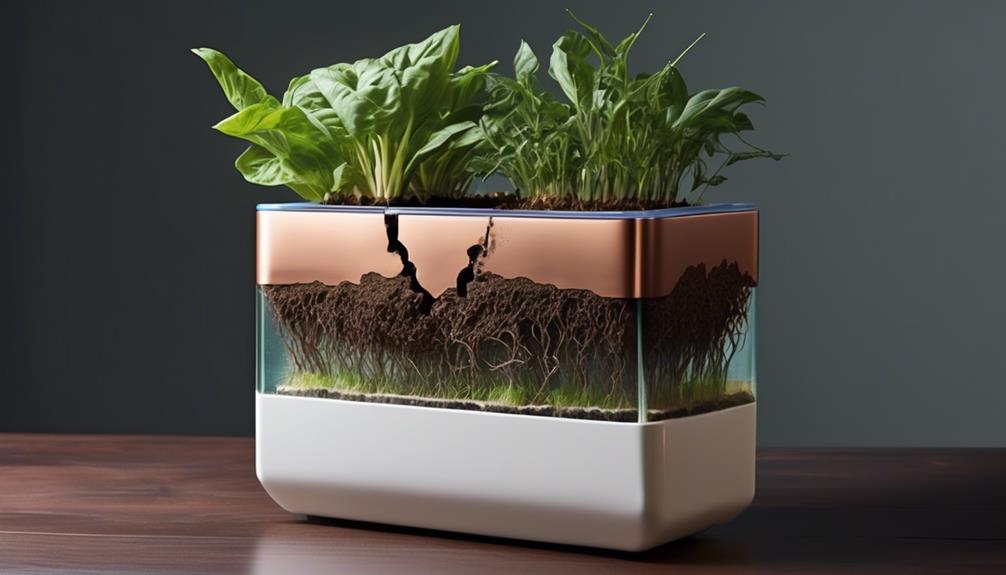
Monitoring soil moisture levels is essential for maintaining the health and growth of plants in self-watering planters. The wicking mechanism plays a crucial role in ensuring even distribution of water throughout the soil.
The wicking mechanism operates through capillary action, where water is drawn upwards through a porous material, such as soil or a wick, due to the forces of adhesion and cohesion.
Here's how the wicking mechanism works:
- Capillary Action: The wicking mechanism relies on capillary action, where water moves upwards through the soil or wick due to the attraction between the water molecules and the material's surface. This action allows water to be distributed evenly throughout the planter, reaching the roots of the plants.
- Water Absorption: The wick, typically made of materials like cotton or nylon, absorbs water from the reservoir and transports it to the soil. This ensures a steady supply of water for the plants without creating waterlogged conditions.
- Even Watering: By facilitating the movement of water from the reservoir to the soil, the wicking mechanism ensures that all areas of the planter receive a consistent level of moisture, promoting uniform growth and healthy root development.
The wicking mechanism is fundamental in self-watering planters, providing a reliable and efficient way to maintain optimal soil moisture levels for plant growth.
Benefits of Self-Watering Planters
Improving plant health and reducing watering frequency, self-watering planters offer numerous advantages for both indoor and outdoor gardening. These planters create an optimal environment for plant growth by ensuring a consistent moisture level in the soil.
By utilizing a wicking system, water is drawn up from the reservoir as needed, providing a steady supply to the roots. This continuous moisture supply results in healthier plants with stronger root systems, leading to improved overall growth and vitality.
In addition to promoting plant health, self-watering planters also contribute to water conservation. The reservoir design minimizes water wastage by delivering only the necessary amount to the plant, reducing the risk of overwatering and evaporation. This efficient use of water not only benefits the environment but also saves time and effort for gardeners, as they need to water their plants less frequently.
Furthermore, the reduced watering frequency can be particularly advantageous for individuals with busy schedules or those who may struggle with regular plant maintenance.
Frequently Asked Questions
Can Self-Watering Planters Be Used for All Types of Plants, Including Those That Require Less Water?
Yes, self-watering planters can be used for all types of plants, including those that require less water. The watering frequency can be adjusted based on the specific water needs of the plants.
This makes self-watering planters suitable for container gardening and aids in water conservation. The design allows for efficient water delivery, preventing overwatering for plants that require less water, while still accommodating those with higher water requirements.
What Are the Best Types of Soil to Use in Self-Watering Planters?
When choosing soil for self-watering planters, we aim for a mix that retains moisture without becoming waterlogged. The ideal blend includes peat moss, coconut coir, and perlite for aeration.
Our research shows that a 50-50 mix of peat moss and coconut coir provides excellent water retention while allowing for proper drainage.
Regular watering with a balanced liquid fertilizer is key to maintaining healthy plants in self-watering systems.
Are There Any Maintenance Tasks Required for Self-Watering Planters, Aside From Refilling the Reservoir?
Maintenance tips for self-watering planters are essential for their effectiveness. Aside from refilling the reservoir, we recommend regular cleaning to prevent clogs and mold growth.
Check the soil moisture levels to ensure the system is functioning properly. Periodically inspect the wicking mechanism and replace it if necessary.
These easy tasks greatly benefit the longevity and performance of self-watering planters. Troubleshooting any issues promptly will help maintain their effectiveness.
Can Self-Watering Planters Be Used Outdoors in All Weather Conditions?
Yes, self-watering planters can be used outdoors in all weather conditions. The outdoor durability and climate resistance of these planters make them suitable for various environments.
Additionally, they're water efficient and can sustain drought-tolerant plants, making them ideal for outdoor use.
These features make self-watering planters a convenient and reliable option for maintaining healthy plants in outdoor settings, regardless of the weather conditions.
Are There Any Potential Drawbacks or Limitations to Using Self-Watering Planters?
Potential drawbacks of using self-watering planters include the need for occasional maintenance, such as cleaning the water reservoir to prevent algae growth.
These planters may also limit the types of plants that can be grown due to their specific watering requirements.
However, overall, the benefits of consistent moisture and reduced watering frequency often outweigh these limitations for many gardeners.
Can I Use Self-Watering Planters for Different Types of Plants?
Yes, varied types of plants benefit from using a self watering planter. From succulents to herbs, the convenience of a self-watering planter ensures that different plant species receive the appropriate amount of moisture without the need for frequent watering.
Conclusion
In conclusion, self-watering planters operate through capillary action, reservoir systems, soil moisture sensors, and wicking mechanisms to provide consistent and efficient watering for plants.
For example, imagine a self-watering planter in a hot, sunny location, where the reservoir system ensures that the plant's roots are always supplied with the necessary water, even during periods of extreme heat.
This innovative technology helps to maintain healthy and thriving plants, making gardening easier and more convenient for all.


